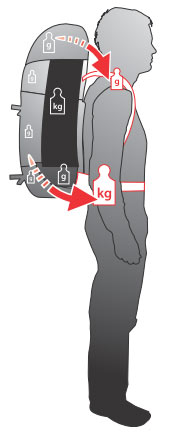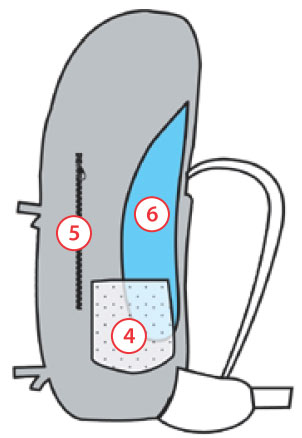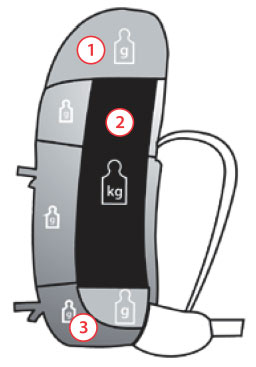With some basic orientations we can balance the weight and distribute the load of the backpack to keep the health of our back safe.
Weight distribution
A correct distribution of weight is essential to be able to use the backpack with high loads during a route without suffering injuries or overloads.
A first idea is to get the center of gravity of the load to be as close as possible to the back,centered on both height and width. That is, the backpack must be attached to the back and without more weight on one side than on the other so as not to cause inertia when walking. If this is not achieved, it will seem that you carry more weight than you actually carry and will increase muscle tension making your step more uncomfortable.
As a general rule, no more than 25% of one’s own weight should be loaded during a long-distance route under medium conditions. Only prepared people can exceed these percentages and on very easy routes.
Approximately 80% of the weight of the backpack should fall on the hips and the rest on the shoulders.
It is not advisable to hang objects on the outside of the backpack as they can unbalance you. In addition, they make it difficult to walk in narrow passages and can be easily lost.
Loading zones
(1) Top
Perfect area for small elements with easy access such as a mobile, GPS, compass, cap, etc. Never put heavy or bulky objects, such as a large bottle of water, that destabilize a lot and can hit you on the head.
(2) Central body
It is the area of more volume so you must have a certain order in its filling. Lighter elements, such as clothing, should occupy the lower, side and upper parts. And the heaviest should be in the central part closest to the body. These heavy items can be the hard material, the tent, cans of food, etc.
(3) Lower compartment
Most backpacks over 40 liters have a lower pocket. This area is ideal for elements of low weight and a lot of volume that would occupy too much in the central compartment such as a sleeping bag, dirty clothes or slippers.

(4) Outer and net pockets
Designed for small elements that you want to have on hand,for example waterproof or various accessories. As we said, it’s important to keep about the same load on both sides of the backpack. Being easy to access outer pockets, you always have to be careful against possible theft or loss.
(5) Map pocket
Many field backpacks have a pocket specially designed to carry various types of maps. They are also prepared to access them easily without having to open the main compartment.
(6) Hydration system
Inner pocket that is separated and prepared to transport hydration bags without harming the comfort of use. The exit point of the hydration tube is usually near one of the shoulder handles.
These are some initial recommendations. In each outing we learn a little more about our backpack and about ourselves so we can adjust the loads with the passage of days according to our particular taste.


We are also in